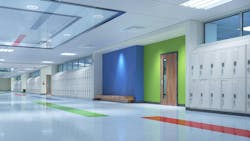A school facility is likely to have a variety of flooring types—carpeting may make sense for some areas, and resilient flooring such as vinyl composition tile may be a preferable option in other spaces.
Each has its advantages and disadvantages, and which flooring types planners and designers choose may involve numerous factors—the function of a space, installation cost, aesthetics, durability, cleaning and maintenance requirements, environmental concerns, staff preferences, among others.
The U.S. Department of Energy's National Best Practices Manual for Building High Performance Schools says that carpeting is most suitable for classrooms, libraries and administrative areas. Resilient flooring is most suitable for high-traffic areas such as hallways, kitchens, cafeterias, art rooms, bathrooms or anywhere that liquid spills are likely.
The U.S. Environmental Protection Agency (EPA), acknowledging that carpet and resilient flooring are the most commonly used flooring types in schools, says that no matter what type of product is chosen, an effective cleaning and maintenance program is essential.
“Designers should explicitly consider cleaning and maintenance issues when specifying flooring finishes for various uses in schools,” the EPA says.
If resilient flooring is chosen, the agency says, schools should select a floor that has been tested for volatile organic compound (VOC) emissions and can be easily cleaned and maintained with low-VOC cleaners and finishes.
“Flooring with high-performance coatings ('low maintenance') should be considered to reduce maintenance costs and the use of cleaners and floor finishes,” the EPA says. “Low-VOC cleaners and floor finishes are available....Use of the wrong maintenance materials can damage resilient flooring. To help ensure longer life, maintain appearance, and protect indoor air quality, resilient flooring requires proper maintenance.”
Durability is one of the key benefits of resilient flooring. It can withstand constant foot traffic and heavy furniture movement, and tends to last longer than other flooring choices. It also is more easily cleaned than carpet.
Carpet
If a school specifies carpet for one of its spaces, the EPA says, it should choose products that have been tested for VOC emissions, can be easily cleaned and maintained, are constructed to prevent liquids from penetrating the backing layer where moisture under the carpet can result in mold growth, and can be easily removed without the use of toxic chemicals.
Comfort and acoustical benefits are most commonly cited as a key benefit of carpeting in school spaces.
“For teachers and staff who stand throughout the day, a cushioned walking and standing surface reduces leg fatigue,” the Carpet and Rug Institute says. “Carpet also provides a non-glare surface that reduces reflection and eyestrain.”
The institute also says that carpeting provides more thermal comfort because it retains inside ambient temperatures longer than hard flooring does and is more effective at reducing ambient noise than other flooring choices.
Carpet also can be a reservoir for dust, dirt, pollen, mold spores, pesticides and other materials that may originate indoors or be brought in from outside, the EPA says.
“If kept very clean from the time it is installed, carpet can trap a significant amount of particles, which can be removed through regular and effective vacuuming,” the agency says. “However, inadequate maintenance can allow large quantities of dust and debris to build up in carpet.”
An effective cleaning regimen is critical for carpet care.
“To help ensure longer life, maintain appearance, and help protect indoor air quality, carpet requires regular vacuuming with a well-functioning vacuum cleaner equipped with strong suction and a high-performance filtration bag and periodic wet extraction cleaning,” the EPA says.
Entry mats
Another key element in school flooring, regardless of the type of flooring, is use of entry mats, which are critical in trapping soil, pollutants, and moisture that otherwise would spread into and throughout the building,
Without an entry mat system, the EPA says:
- School entrances and lobbies can become unsightly and leave a poor first-impression about the maintenance and condition of the building.
- Dirt and pollutants can spread to larger areas and cause higher maintenance costs than otherwise would have been necessary.
- Moisture tracked onto hard-surface floors can increase the chance of injuries and can reduce the life of carpet.
- Increased grit tracked onto smooth-surface flooring can grind away the protective finish, and cause carpets to quickly become loaded with pollutants.
About the Author
Mike Kennedy
Senior Editor
Mike Kennedy has been writing about education for American School & University since 1999. He also has reported on schools and other topics for The Chicago Tribune, The Kansas City Star, The Kansas City Times and City News Bureau of Chicago. He is a graduate of Michigan State University.
